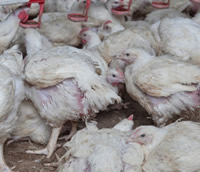Rapid Growth
- Rapid growth causes skeletal and metabolic disorders causing suffering, pain and death. 90% of chickens have a detectable abnormal gait at the age they are slaughtered (5).
- Due to the rapid growth of the birds many of them develop skeletal issues causing lameness. Each year in Australia roughly 165,401,790 chickens will suffer from skeletal issues and lameness impairing their ability to walk (5*).
 Rapid growth can also cause the tendon that runs along the back of the leg to rupture due to the excess weight placed on the tendons (5).
Rapid growth can also cause the tendon that runs along the back of the leg to rupture due to the excess weight placed on the tendons (5).- At age 5 weeks to 7 weeks chickens spend 76-86% of their time lying down due to lameness (5). At this stage the floor has accumulated a significant amount of urine and faecal matter from the large number of birds. This build-up of faeces and urine causes strong ammonia levels and can cause lying birds to develop painful breast blisters, hock burns (a painful burn at the hock joint) and footpad dermatitis. To make matters worse, as a way to save on costs, grower farmers often recycle litter between batches (3). This means the 6-8 weeks of faecal build up from the last batch of birds is left in the shed and the second batch is forced to live in these faeces as well as the build-up of their own. This could double the amount of ammonia present, as well as the effects of such ammonia exposure.
- Accelerated growth can also lead to sudden death syndrome, an acute heart failure. This occurs in 1-4% of chickens. Of the half a billion farmed in Australia each year, that's up to 22,053,572 chickens who will die of sudden death syndrome (5*).
- Ascites is the major cause of death in chickens as they reach slaughter weight. Ascites is caused by accelerated growth where the juvenile heart and lungs can't transport enough oxygen to the overgrown body.
- As the birds grow their condition worsens and they become less mobile, unable to reach the waterers and feeders. In an article in The Guardian (14/10/1991) Professor John Webster of Bristol University's veterinary school said: "Broilers are the only livestock that are in chronic pain for the last 20 percent of their lives. They do not move around not because they are overstocked but because it hurts their joints so much."
